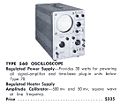560
The Tektronix 560 is a scope introduced in 1961 which uses 50 and 60 series plug-ins for both the vertical and horizontal deflection.
It is the first of the 560-series scopes, which contain no amplifier stages, requiring the plug-ins to directly drive the CRT deflection plates. While promoted by Tek as having the advantage of “not limited by additional circuitry between the plug-in and the deflection plates”, this configuration has the significant disadvantage that gain or sweep need to be calibrated individually each time a plug-in is swapped to even get crude accuracy, as the raw deflection factor of the CRT varies to a relatively large degree between units, and the mainframe has no circuitry to normalize this difference.
In scopes that have amplifiers in the mainframe, this step can be skipped, as doing so only tunes the accuracy to a small amount of additional precision.
It may be for this reason that Tektronix referred to the 560 series mainframes as “indicators” rather than oscilloscopes.
The 560 was introduced along with the similar 561 in 1961. A rack model was never offered. Both of the mainframes use conventional 5” round CRTs with glass envelopes.
The 561 also supports the 70 series plug-ins which are not compatible with the 560. Certain members of the 70 series vertical amplifiers give a system bandwidth of 4 MHz in the 561. The later 2- and 3- series plug-ins cannot be used in the 560 or 561, as they consume more power.
The 560 and 561 were short-lived. Both were replaced by the 561A, which offered several performance improvements, within less than a year.
Key Specifications
- please add
The maximum system bandwidth of the 560 is 1 MHz.
Internals
The 560 uses a T5030 CRT, referred to as a "T503P2" (P2 phosphor) in the manual. The CRT has -3,300 V on the cathode and +175 V on the aquadag.
The only circuit in the 560 apart from the CRT circuits and power supply is a voltage/timing calibrator.
Power Supply
The 560 has a power supply that is similar to the 503's power supply. Mains power first passes through transformer T601, which produces unregulated AC heater current and 170 VRMS for the second part of the power supply.
The second part is a regulated Armstrong power oscillator operating at 25 kHz, using transformer T620 and a V620, a 6DQ5. The secondary outputs of T620 are simply rectified and filtered, producing -12 V, +125 V, -100 V, and -3,400 V. All regulation is performed by controlling the screen grid voltage on V620, the power oscillator tube.
In principle, the design used in the 560, which resembles a modern SMPS supply, like that in a 7704, can offer higher efficiency and lower tube count compared to the power supply of the 561, which uses a traditional design more similar to a 545.
The increased efficiency comes from the elimination of series regulator tubes, which typically operate with around 100 V across them. The tube count reduction comes from eliminating the pass tube and the error amplifier for each regulated voltage that the power supply produces. Additional efficiency is gained by the 560's power supply because it doesn't need to supply heater current to all of those tubes.
The 560 provides a maximum total of 25 watts of DC power to the plug-ins, less than other 560-series mainframes. Plug-ins whose model number starts with a 3 (e.g., the 3A6) are not electrically compatible with the 560 because their power draw exceeds what the 560 can provide.
Pictures
-
-
-
-
Description in 1962 Catalog
-
-
-
-
-
-
-
Power Supply Schematic












